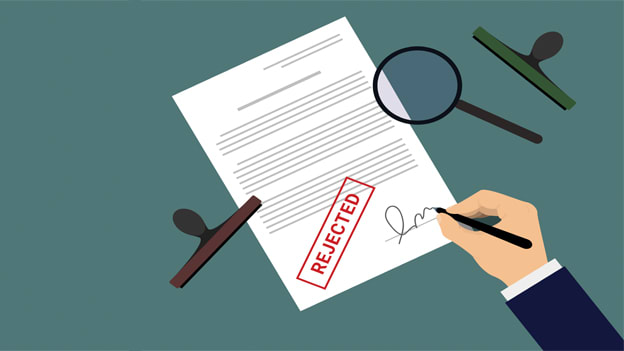Workplace Rejection: What must be done

Hurt comes to us in many ways and possibly one of the worst kinds is that which springs from being rejected. Take Mark, for instance, who was looking for a job that he thought would suit him best. He finally found one and thought he had aced the interview. The very thought of working in an organization that he had dreamt of and an opportunity to express himself was keeping Mark elated. On the day that he was to receive his confirmation letter, he received a letter saying he wasn’t selected for the role. This rejection was not taken lightly by Mark and he started feeling shaky, abandoned, hopeless and upset. A sense of not being worthy started creeping into him. This is just one example of the many situations where we feel dejected because of our sense of rejection, and even though Mark is just a fictional character, we all know that we at some point or the other have felt that feeling of dismay.
Rejection comes in many forms. For example, you were expecting a promotion and your colleague got it, your application was rejected for reasons that you do not know, your coworker got the credit for your contribution to the project. And then there are life-altering rejections like being fired from the job, spouse leaving his/her partner, and so on.
Whatever the rejection - big or small - the one thing that is common is that it always hurts. If this hurt is not addressed or attended to, it is very easy for one to go into a downward spiral of self-doubt. The little voice in the head like, “I am not good enough”, “life is unfair”, “why me?”, “is there something seriously wrong with me?” takes over. We feel ashamed and inadequate.
Now, does everyone feel that way? Not necessarily. For some, rejection ignites a spark inside. It becomes a fuel for some to take on challenges with vigor, despite the feelings of hurt. The voices in the head of such people reflect things like “I will prove you wrong”, “no matter what, I will succeed”. With this focus and determination, some achieve extraordinary results and success.
Take the example of Jack Ma, founder, and CEO of Alibaba. His message- Never Give up, because it is to the persistent tryers that the world truly belongs. In his interview with Bloomberg TV, he mentions, he had applied for jobs 30 times and was rejected. In many cases, he was the only one who got rejected. Rejected by KFC, Police forces, and ten times by Harvard. Despite so many rejections what allows people like Jack Ma to bounce back?
Emmy E Werner, an American development psychologist in her research on Resilience in development and subsequent researches on this topic has found a common thread – Individual dispositions and sources of social support are factors that contribute to resilience.
Based on my experience, I believe dealing with rejection is a three-step process – Being Aware (or Being), Dealing with Rejection Head On (or Doing) and Creating a support structure.
Being Aware (Being) - Self-awareness is the starting point. Observe the little voice in your head. What is it saying, when you are rejected? Focus on ‘being’ with the thought, without judging or evaluating – ‘Just Be’. The sooner you realize your being, the better it is. Awareness comes from practice and by being mindful. You will realize that rejection is a point of view of the other person and it has nothing to do with you. The Rule No.6 in Benjamin Zander’s book, The Art of Possibility, is “Don’t take yourself so damn seriously”, and a simple shift in the way we think can loosen the grip of our image of self, and break the hold of a negative self-image.
Dealing with Rejection Head On (Doing) - The idea is to go out and look for rejection. After you have had enough of that, you will be able to overcome the pain. In psychotherapy, this approach is called ‘Exposure Therapy’. This is particularly interesting because it involves the exposure of oneself to a feared situation/object/context without any danger to overcome the anxiety/fear. This concept inspired Jia Jiang to author Rejection Proof to start a 100-day rejection seeking exercise.
In Jia Jiang’s own words, what he learned in the whole process is listed as three points below:
- Rejection is a muscle. If you do not constantly work outside your comfort zone, you will lose it and become weak.
- Rejection is a number game. Fight through enough NO’s and you will eventually find a YES
- Avoiding rejection is worse than receiving it. When we shy away from rejection, we reject our ideas and ourselves before the world ever has a chance to reject them. This is the worst form of rejection and as a result, we are ignored by the world.
- Creating a Support structure – Creating a network of people who can be committed listeners to each other. Having people who can act as a sounding board, sharing our thoughts and being a sounding board for others, gives an opportunity for one to see the situation from a different perspective. It is all about give and take, empowering others and in turn, being empowered.
Zig Ziglar, a famous speaker says,” If you help others achieve what they want, you will get what you want”.
Simply put, working with others to ensure that we reinforce others capacity to bounce back.
Rejection is an opportunity for us to learn and evolve from our own experiences. It can be painful, but viewing rejection as an opportunity will allow us to move in an upward spiral of life.
Is it possible?
Yes.
Is it easy?
I will leave it to you.
(The views expressed in the article are author’s own and the author’s employer does not subscribe to the substance or veracity of the views expressed herein)











